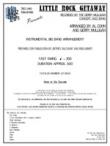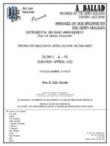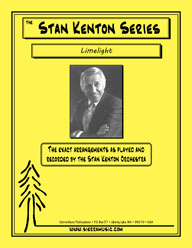IF YOU WERE THE ONLY GIRL (IN THE WORLD) [DOWNLOAD]
As Recorded by Gene Krupa
Arranged by Gerry Mulligan, Edited by Jeffrey Sultanof

Cat #: JLP-8450-DL
$75.00This product is available for immediate download after purchase.
Questions?
Please call +1-518-587-1102 or email us.
Edition: Jazz Big Band Arrangement
Description: Ballad - Difficult
Publisher: Jazz Lines Publications
Background:
Gerry Mulligan was a precocious young musician of seventeen when he walked into the studios of radio station WCAU in Philadelphia and asked staff arranger/conductor John Warrington if he could write arrangements for the house big band. Warrington looked at his work, made some suggestions, and then commissioned music from Mulligan. Gerry moved on to the Tommy Tucker band, and Tucker, while recognizing the talent that Mulligan showed, told him that his music was too advanced for his band. Mulligan went back to Philadelphia and wrote arrangements for the WCAU band again, now led by Elliot Lawrence.
His big break came when, in January of 1946, he joined the Gene Krupa Orchestra as a saxophonist/arranger. He was not as skilled a player at the time as he later became, and the band threatened to quit as a group if he was not replaced. On the road with the most versatile ensemble he'd yet written for, he wrote about twenty-four compositions and arrangements and sometimes filled in on alto and tenor. Krupa bought and played all of his music, and yet he often had to reign in his young charge. Disk Jockey Jump was a big hit for the band, but some of Mulligan's music was experimental and flirted with bop and advanced harmony (Mulligan had jammed with Charlie Parker when he was living in Philadelphia). Mulligan was cocky and opinionated, and the two men clashed at times. Yet this was a very good match; Mulligan had a mentor he respected at a time when Gene was considered old-fashioned by many young musicians, and Krupa encouraged the young man as he would his own child. When they saw each other three months before Krupa's death in 1973, they hugged and apologized for the way they treated each other.
In 1958, Krupa recorded an album of twelve of these arrangements for Verve Records. Gerry was delighted to find that the music of his youth held up quite well, and the all-star studio big band roars throughout, clearly enjoying the music. It is one of the best big band albums of its time, and at this writing, is still available on CD.
The Music:
If You Were the Only Girl in the World was written in 1916 and was still a very popular waltz thirty years later. It is one of the few ballad arrangements Mulligan wrote during his year with Krupa. Mulligan converts the waltz into a slow fox trot gracefully while exploring modern harmonies and counterlines. This was a daring piece of music for a mainstream orchestra at the time, with its tritone motif appearing at various times in the piece, and suspension of the underlying rhythm for several bars at times.
This is one of the few arrangements from the Krupa book that has survived in its original form (not including published stock arrangements). Krupa's home caught fire some months before he died, and his music, awards and much more was lost forever. "A year of my life went up in smoke," was how Mulligan described the situation. The parts used for this edition were discovered in the collection of trombonist/arranger Marshall Brown. Brown, along with Clem DeRosa, was a pioneering jazz educator in Long Island, NY. Brown led an ensemble of teenagers for a few years called the Newport Youth Band, whose alumni included Alan Rubin, Eddie Gomez, Mike Abene, Jimmy Owens, Ronnie Cuber and Larry Rosen. If You Were the Only Girl in the World was part of the Youth Band book and as a result is one of the only surviving original arrangements from the Gene Krupa band library.
The parts were handcopied from the originals, photocopying not yet widespread in 1958. Marky Markowitz's treatment of the melody on harmon-muted trumpet was transcribed by Brown, who made some omissions and changes to the music for some unknown reason. This edition 'fixes the fixes' and is a restoration of Mulligan's original arrangement.
Notes to the Conductor:
Talk about an unusual treatment of an old song! This music could have been written yesterday, and one can see why Gil Evans was tremendously impressed by young Gerry Mulligan. Substitute harmonies are tasteful, and Gerry was already showing his mastery of linear writing. The previously-mentioned tritone framing device is also quite effective, although its stark unison must have shocked dancers and listeners.
The tempo should not drag, but neither should the music speed up, challenging issues whenever music of this tempo is played. Making things even more difficult are the several sections where there is no rhythm playing at all, and the musicians must find their own way to keep the tempo steady. The conductor may want to design exercises to practice this. Measures with syncopation must be perfectly synchronized (even some of the musicians on the recording don't nail all of them). The last two bars are in tempo to the very end; the ending should still shock and surprise.
Dynamics are particularly important in this setting. There is a difference between pianissimo and mezzo-piano. If the ensemble peaks early with regard to volume, the effectiveness of this music is lost. With plenty of rehearsal and careful listening, your band will find its own way to bring this music to life.
2 Alto Saxophones
2 Tenor Saxophones
Baritone Saxophone
4 Trumpets
4 Trombones
Guitar
Piano
Bass
Drums









